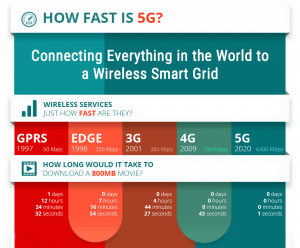The State of 5G: When It’s Coming, How Fast It Will Be & The Sci-Fi Future It Will Enable
The State of 5G
Although 5G may seem like just another generational upgrade for mobile networks, touting more speed and less latency than previous iterations, the years-long migration will require an expansion of cellular networks worldwide to include millions of new antennas that will become the backbone of IoT (Internet of Things) and its billions of sensor-laden devices, from smart dust to smart cars.
READ ALSO –>
SAMSUNG GALAXY S9 ARRIVES TODAY: 5 THINGS TO KNOW
Many industries expect 5G to generate billions of dollars through currently unrealized revenue streams, providing an endless supply of applications and services to the more than four billion additional people 5G is hoped to reach. Qualcomm for example predicts that by 2035, the network will enable $12 trillion worth of goods and services and the company has claimed in the past that 5G will be “bigger than electricity,” while the World Economic Forum describes the era we’re entering as being “the Fourth Industrial Revolution”.

“If something can be connected, it will be connected to 5G.” – Former FCC Chairman Tom Wheeler
Although it appears 5G phones won’t be coming until at least 2019, broad scale demonstrations of early 5G networks have recently taken place at this year’s Super Bowl in Minneapolis and
How Fast is 5G?
The International Telecommunication Union (ITU), a division of the UN dedicated to the oversight of global telecommunications tech (radio, television, satellite, telephone and the Internet), established the IMT-2020 program (International Mobile Telecommunication for 2020 and beyond) in early 2012 to begin the global race toward 5G.
The ITU has defined key 5G
performance as being a peak minimum download speed of 20Gb/s (100Mb/s “user experienced rate”), a peak minimum upload of 10Gb/s (50Mb/s “user experienced rate”), as well as millisecond latencies and support for 100 devices per square meter (1 million devices per square kilometer).
By comparison, 4G’s standards call for a peak download of 100Mb/s and upload of 50Mb/s, while a recent report pegged T-Mobile as having the fastest 4G LTE download speeds in the U.S. topping out at 19.4Mb/s, second to Verizon’s 17.8Mb/s. Meanwhile, for reference, Qualcomm’s upcoming 5G modem chip (the Snapdragon X50), is said to be capable of speeds of up to 5Gb/s, a theoretical limit that exceeds the data rate of even many fiber-based wired connections.
Upgrading from 56K dial-up to cable Internet seems like an apt comparison for the performance that 5G promises to deliver and it will be made possible through a three-pronged approach to build-out efforts: 1) overall network bandwidth (support for billions of new connected devices), 2) super low latency (1ms response times), and 3) an emphasis on reliability, even in highly congested environments or indoors.
<
A successful deployment of 5G would bring wireless speeds capable of streaming multiple 4K videos at once without buffering or any other lag and that performance will usher in the emerging age of IoT while also opening the door for high-bandwidth products and services such as live-streaming virtual reality sporting events or receiving remote surgery.
- 5G-enabled smartphones: With 5G, consumers will almost never again need to log on to public Wi-Fi. They will also enjoy faster browsing, faster downloads, better quality video calls, UHD and 360-degree video streaming and instant cloud access than currently available.
- Always Connected PCs: With the advent of 5G networks, “always connected” PCs will be able to utilize super high speed, low latency connectivity for the next level of cloud services, as well as high-quality video conferencing, interactive gaming and increased productivity due to the flexibility to work anywhere.
- HMDs: 5G enhanced mobile broadband will further elevate virtual reality (VR), augmented reality (AR) and extended reality (XR) experiences with its increased capacity at lower cost and ultra-low latency – down to 1 millisecond.
- Mobile Broadband: Fiber speeds and massive capacity to support insatiable consumer demand for unlimited data, as well as superior mobile and home broadband internet access.
Much work remains in upgrading/meshing current mobile, fixed, optical and satellite infrastructure to accommodate 5G technologies, but many companies are striving for launch by 2019, with 5G coverage anticipated to reach around 20% of the world’s population, according to Ericsson.
read on applygist.com
Discover more from Applygist Tech News
Subscribe to get the latest posts sent to your email.
